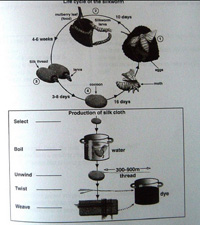cldales /
Apr 18, 2015 #1
The diagram illustrates the life cycle of the silkworm, and the process on how to yield the silk cloth from it. It is apparent that the silkworm's cocoon is where the silk cloth is derived from, and overall, the production of it is composed of five stages.
On the one hand, the life cycle of the silkworm starts when a moth lays eggs on a mulberry leaf. Then, the eggs become silkworm larvae after 10 days; the mulberry leaf is their source of food. In 4-6 weeks, the larvae start to engulf themselves with silk threads until they form a cocoon in another 3-8 days. The larvae stay inside their respective cocoons until they become moths. The cycle is repeated when a moth again lays eggs.
On the other hand, cocoons can be harvested to produce the silk cloth. First, the cocoons are selected, placed in water and then boiled. Next, the cocoons are unwound. Each cocoon could yield approximately 300-900 meters of silk thread. The silk thread is twisted to form a yarn. Lastly, the yarn could be dyed directly or woven first before dyeing.
On the one hand, the life cycle of the silkworm starts when a moth lays eggs on a mulberry leaf. Then, the eggs become silkworm larvae after 10 days; the mulberry leaf is their source of food. In 4-6 weeks, the larvae start to engulf themselves with silk threads until they form a cocoon in another 3-8 days. The larvae stay inside their respective cocoons until they become moths. The cycle is repeated when a moth again lays eggs.
On the other hand, cocoons can be harvested to produce the silk cloth. First, the cocoons are selected, placed in water and then boiled. Next, the cocoons are unwound. Each cocoon could yield approximately 300-900 meters of silk thread. The silk thread is twisted to form a yarn. Lastly, the yarn could be dyed directly or woven first before dyeing.

Untitled.jpg
